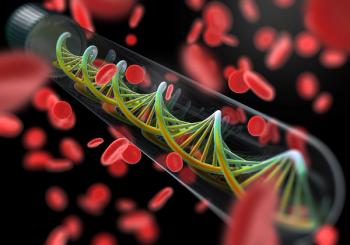
- ONCOLOGY Vol 12 No 1
- Volume 12
- Issue 1
Autocrine Growth Factors and Neuroendocrine Markers in the Development of Small-Cell Lung Cancer
Two different clinical trials using biological agents directed against an autocrine growth factor and a surface marker of neuroendocrine differentiation have been used for patients with relapsed small-cell lung cancer. In a
ABSTRACT: Two different clinical trials using biological agents directed against an autocrine growth factor and a surface marker of neuroendocrine differentiation have been used for patients with relapsed small-cell lung cancer. In a phase II trial, an antibody (2A11) directed against the autocrine growth factor gastrin-releasing peptide has been used to treat patients with relapsed small-cell lung cancer. One of 12 evaluable patients treated with 2A11 250 mg/m² three times weekly for 4 weeks achieved a complete response. An antibody directed against the neural cell adhesion molecule has been linked to a modified ricin molecule. This immunotoxin, N901-bR, has undergone phase I testing, and a recommended phase II dose of 30 mg/kg/day for 7 days by continuous infusion has been determined. In the phase I trial, one of 21 patients with relapsed or refractory small-cell lung cancer had a partial response to this treatment. Therefore, it appears that an antibody directed against an autocrine growth factor and an immunotoxin directed against a surface marker of neuroendocrine differentiation can inhibit the growth of small-cell lung cancer in vitro and in vivo; both produced some evidence of antitumor activity in patients. Further studies with agents directed against autocrine growth factors and surface markers of neuroendocrine differentiation appear warranted. [ONCOLOGY 12(Suppl 2):11-14, 1998]
Human lung cancers are divided both clinically and biologically into small-cell lung cancer and non-small-cell lung cancer, each having distinctive histologic, clinical, and biologic features.[1] One distinguishing feature is that small-cell lung cancer more commonly has markers of neuroendocrine differentiation than are seen with non-small-cell lung cancer. These markers may include enzymatic activity, such as L-dopa decarboxylase and neuron-specific enolase, peptide hormones, including arginine vasopressin and gastrin-releasing peptide, and surface markers, such as the neural cell adhesion molecule. These autocrine growth factors and markers of neuroendocrine differentiation in small-cell lung cancer provide distinguishing biologic characteristics for the development of novel therapies. Presented here are data from two clinical trials[2,3] in which patients with small-cell lung cancer were treated using biologic agents directed against an autocrine growth factor or a surface marker of neuroendocrine differentiation.
Rationale
The autocrine growth loop in cancer was first described as a potential growth pathway for cancer cells by Sporn and Todaro more than 17 years ago.[4] An autocrine growth factor is defined as cellular production of a growth-promoting, hormone-like substance for which the cell itself has functional receptors. Gastrin-releasing peptide fits this definition, because it can be produced by lung cancer cells, secreted, bind to its receptors, and stimulate growth of the lung cancer cells themselves.[1] A murine monoclonal antibody, 2A11, has been produced that can bind to gastrin-releasing peptide and prevent the autocrine growth of small-cell lung cancer cells in vitro and in vivo.[5] This monoclonal antibody directed against an autocrine growth factor has been brought to clinical trial for patients with relapsed small-cell lung cancer.
The neural cell adhesion molecule (NCAM) is a cell-surface marker of neuroendocrine differentiation and a member of the immunoglobulin superfamily involved in cell-to-cell interactions.[6,7] NCAM (CD56) is an appropriate surface target, because it is present on nearly 100% of small-cell lung cancer cell lines and tumors tested.[8,9] A murine monoclonal antibody, N901, mediates high-affinity binding to the NCAM.[2] This antibody has been covalently linked to a modified ricin molecule.[10] The ricin molecule is composed of an alpha chain that inactivates eukaryotic ribosomes, thereby inhibiting protein translation, and a beta chain that mediates nonspecific binding to cell-surface galactose moieties. In the modified molecule, the beta chain has been chemically modified to prevent this nonspecific binding to galactose moieties on cells, so the binding is mediated by the more specific N901 antibody.[10] The immunotoxin is called N901-blocked ricin (N901-bR). This immunotoxin directed against a surface marker of neuroendocrine differentiation has been brought to clinical trial for evaluation in patients with relapsed or refractory small-cell lung cancer.
Material
Patients with small-cell lung cancer who had either progressed or relapsed after chemotherapy treatment were eligible for these studies of therapy with the monoclonal antibody 2A11 or the immunotoxin N901-bR[2,3]. Eligible patients were required to have a good performance status and normal hematologic, hepatic, renal, cardiac, and neurologic function. A more detailed description of the eligibility and exclusion criteria is available in the original publications.[2,3] Tumor response to the trial therapy was assessed using standard criteria.[11]
The 2A11 murine monoclonal antibody was administered at a dose of 250 mg/m² intravenously over 1 hour each Monday, Wednesday, and Friday for 4 weeks. Patients who achieved a partial or complete response to treatment were eligible for additional courses of 2A11. The 2A11 murine monoclonal antibody was produced in sufficient quantities to treat 14 patients. Serum samples were obtained prior to each dose and stored at -70ºC. Measurements of the 2A11 antibody levels and human antimouse antibody were performed using techniques previously described.[12,13]
The first 10 patients treated received N901-bR immunotoxin administered at dose levels of 5, 10, and 20 µg/kg/day on the first day as a 60-minute infusion to allow for pharmacokinetic studies. Twenty-three hours after the 60-minute infusion, a 6-day infusion was begun. Patients treated at doses of 30 and 40 µg/kg/day received N901-bR for 7 days, administered as a continuous infusion. The first 13 patients were treated at their actual body weight, and the final eight patients were treated at lean body mass. This policy of treating by actual or lean body weight has been reported previously.[2] All patients had serum samples drawn daily on days 0 through 7. N901-bR, human antimouse antibody, and human antiricin antibody were determined using techniques previously described.[2] Patients were eligible for additional courses of N901-bR if they did not develop disease progression or human antimouse or antiricin antibodies.
Results
In the 2A11 trial, 13 patients with small-cell lung cancer (nine men and four women) were treated with 2A11 250 mg/m2 three times per week. Of the 13, 11 received all 12 doses of the 2A11 antibody. One patient did not complete the 12-dose regimen because of disease progression, and one patient died during treatment of a gastrointestinal hemorrhage and was not evaluable for response. One of the 12 evaluable patients had a complete response to treatment with resolution of the left upper lobe mass documented by chest radiograph and computed tomography (Figure 1). Four had stable disease, and seven had cancer progression following treatment.
The patient with a complete radiologic response to treatment was treated with a second course and survived without cancer progression for 6 months. She then relapsed in the lung and was treated with a third cycle of 2A11. At that point, however, her cancer progressed in the lung and liver, and she died of small-cell lung cancer 8 months after starting treatment. Her serum levels of 2A11 did not decline with successive cycles (Figure 2) and were typical of the serum levels achieved in the patients in this phase II trial. The mean trough plasma levels of 2A11 for the 13 treated patients were between 21 and 487 µg/mL. The patients did not develop significant human antimouse antibodies during the trial, including the patient who received three cycles of treatment. No grade 3 or 4 toxicities were encountered.[14]
In the N901-bR trial, 21 patients with small-cell lung cancer were treated with N901-bR 5 to 40 mg/kg/day for 7 days, using a phase I dose-escalation scheme.[2] The maximum tolerated dose was 30 µg/kg of lean body weight per day for 7 days. The dose-limiting toxicity was capillary-leak syndrome, which occurred in two of the three patients treated at 40 µg/kg/day. These two patients developed hypotension requiring hospitalization for longer than 48 hours. Of the 21 patients treated, 18 received 7 days of N901-bR. One patient did not complete the 7-day treatment period because of disease progression, and two developed dose-limiting hypotension, which required discontinuation of the infusion. One of the 21 evaluable patients had a partial response to treatment (Figure 3), 6 had stable disease, and 14 had cancer progression following treatment. The patient with a partial response was treated at the maximum tolerated dose and survived without cancer progression for 3 months. She was then treated with conventional chemotherapeutic agents and died of her small-cell lung cancer 18 months after starting treatment with N901-bR.
The serum N901-bR levels of the eight patients treated at the maximum tolerated dose increased until day 4, when steady-state levels were reached (Figure 4). The mean steady-state plasma levels for these patients were approximately 90 ng/mL. Of the 20 patients evaluated, 17 developed human antiricin antibodies within 1 month of the start of treatment; 11 of 20 developed human antimouse antibodies. Only one patient had no evidence of either antibody 7 weeks after the start of the N901-bR infusion. No patient received more than one course of treatment with N901-bR.
Discussion
The presence of autocrine growth factors and neuroendocrine markers in small-cell lung cancer provides potential targets for therapeutic intervention in patients with lung cancer. In this article we have summarized two early reports of clinical trials using biologic agents directed against gastrin-releasing peptide 2A11 and the cell-surface marker NCAM. A 7-day course of N901-bR requires a much lower dose than a 1-month course of 2A11: One cycle of treatment with N901-bR involves approximately 10 to 20 mg, whereas a typical 4-week course of 2A11 treatment calls for 3 to 8 gmore than 100-fold greater. This has important practical implications, because the cost of preparing these biologic reagents can exceed $1,000 per gram.
Trials requiring many grams of a biological agent per patient can make a phase II trial prohibitively expensive to carry out. Despite the difference in doses of 2A11 and N901-bR, the serum concentrations of the two agents were well above concentrations needed for in vitro antitumor activity, because N901-bR is much more potent than 2A11. The murine monoclonal antibody 2A11 has antitumor activity against small-cell lung cancer at concentrations of 3 to 10 µg/mL.[5] The trough serum concentrations achieved in all the patients also were well above that needed for in vitro activity, with a median of 66 µg/mL (range, 23 to 487). The mean steady-state serum concentration of N901-bR in eight patients treated at the maximum tolerated dose was 90 ng/mL, a concentration that causes 4 logs of cell kill in small-cell lung cancer cells exposed to N901-bR for 24 hours.[2,3] This early evidence of antitumor activity in these patients with relapsed small-cell lung cancer treated with either 2A11 or N901-bR provides a conceptual validation for the use of agents directed against autocrine growth factors or markers of neuroendocrine differentiation.[2,3]
The toxicity encountered in these trials has been acceptable. No grade 3 or 4 toxicities were observed with the 2A11 doses used in the phase I trial.[14] In contrast, the patients treated with N901-bR did develop significant toxicity, including dose-limiting capillary-leak syndrome. Preclinical data suggested that N901-bR could cause cardiac and/or neurologic toxicity. In this trial, no clinical neurotoxicity was observed but neurophysiologic abnormalities were detectable in some patients, and cardiac toxicity was apparent in one patient who developed atrial fibrillation and two who developed a myocardial infarction.[2]
The development of human antibodies was a problem with the N901-bR immunotoxin but not with 2A11. All but one patient treated with N901-bR developed antibodies against either N901 or ricin by week 7, a drawback that currently limits the duration of N901-bR administration to a single cycle. Development of human antimouse antibodies has not been observed in patients treated with the murine monoclonal antibody 2A11, which has been given for up to three cycles without development of significant human antimouse antibodies.
Conclusion
The observations of some anticancer effect of the autocrine growth factor 2A11 and the immunotoxin N901-bR are encouraging in the search for improved treatment of small-cell lung cancer. Results of these studies will prompt further research for modifying approaches to blocking autocrine growth and developing molecules targeted against other markers of neuroendocrine differentiation.
References:
1. Johnson BE: Biology and molecular genetics of lung cancer. Semin Respir Crit Care Med 17:299-308, 1996.
2. Lynch TJ, Lambert JM, Coral F, et al: Immunotoxin therapy of small-cell lung cancer: A phase I study of N901-blocked ricin. J Clin Oncol 15:723-734, 1997.
3. Kelley MJ, Linnoila RI, Avis IL, et al: Antitumor activity of a monoclonal antibody directed against gastrin-releasing peptide in patients with small cell lung cancer. Chest 112:256-261, 1997.
4. Sporn MB, Todaro GJ: Autocrine secretion and malignant transformation of cells. N Engl J Med 303:878-880, 1980.
5. Cuttitta F, Carney DN, Mulshine J, et al: Bombesin-like peptides can function as autocrine growth factors in human small-cell lung cancer. Nature 316:123-126, 1985.
6. Rutishauser U, Acheson A, Hall AK, et al: The neural cell adhesion molecule (NCAM) as a regulator of cell-cell interactions. Science 240:53-57, 1988.
7. Cunningham BA, Hemperly JJ, Murray BA, et al: Neural cell adhesion molecule: Structure, immunoglobulin-like domains, cell surface modulation, and alternative RNA splicing. Science 236:799-806, 1987.
8. Doria MI, Montag AG, Franklin WA: Immunophenotype of small cell lung carcinoma: Expression of NKH-1 and transferrin receptor and absence of most myeloid antigens. Cancer 62:1939-1945, 1988.
9. Carbone DP, Koros AMC, Linnoila RI, et al: Neural cell adhesion molecule expression and mRNA splicing patterns in lung cancer cell lines are correlated with neuroendocrine phenotype and growth morphology. Cancer Res 51:6142-6149, 1991.
10. Lambert JM, McIntyre G, Gautheir, MN, et al: The galactose-binding sites of the cytotoxic lectin ricin can be chemically blocked in high yield with reactive ligands prepared by chemical modification of glycopeptides containing triantennary N-linked oligosaccharides. Biochemistry 30:3234-3247, 1991.
11. Johnson BE, Bridges JD, Sobczeck M, et al: Patients with limited stage small cell lung cancer treated with concurrent twice daily chest radiotherapy and etoposide/cisplatin followed by cyclophosphamide, doxorubicin, and vincristine. J Clin Oncol 14:806-813, 1996.
12. Avis IL, Kovacs TO, Kasprzyk PG, et al: Preclinical evaluation of an anti-autocrine growth factor monoclonal antibody for treatment of patients with small-cell lung cancer. J Natl Cancer Inst 83:1470-1476, 1991.
13. Mulshine JL, Avis I, Treston AM, et al: Clinical use of a monoclonal antibody to bombesin-like peptide in patients with lung cancer. Ann NY Acad Sci 547:360-372, 1988.
14. Mulshine J, Avis I, Carrasquillo J, et al: Phase I study of an anti-gastrin releasing peptide monoclonal antibody in patients with lung cancer (abstract). Proc Am Soc Clin Oncol 9:230, 1990.
Articles in this issue
almost 28 years ago
Small-Cell Lung Cancer: Is There a Standard Therapy?almost 28 years ago
Recent Advances With Chemotherapy for NSCLC: The ECOG Experiencealmost 28 years ago
Overcoming Drug Resistance in Lung Canceralmost 28 years ago
Paclitaxel/Carboplatin in the Treatment of Non-Small-Cell Lung Canceralmost 28 years ago
The Role of Carboplatin in the Treatment of Small-Cell Lung Canceralmost 28 years ago
Future Directions in Non-Small-Cell Lung Cancer: A Continuing PerspectiveNewsletter
Stay up to date on recent advances in the multidisciplinary approach to cancer.





















































































